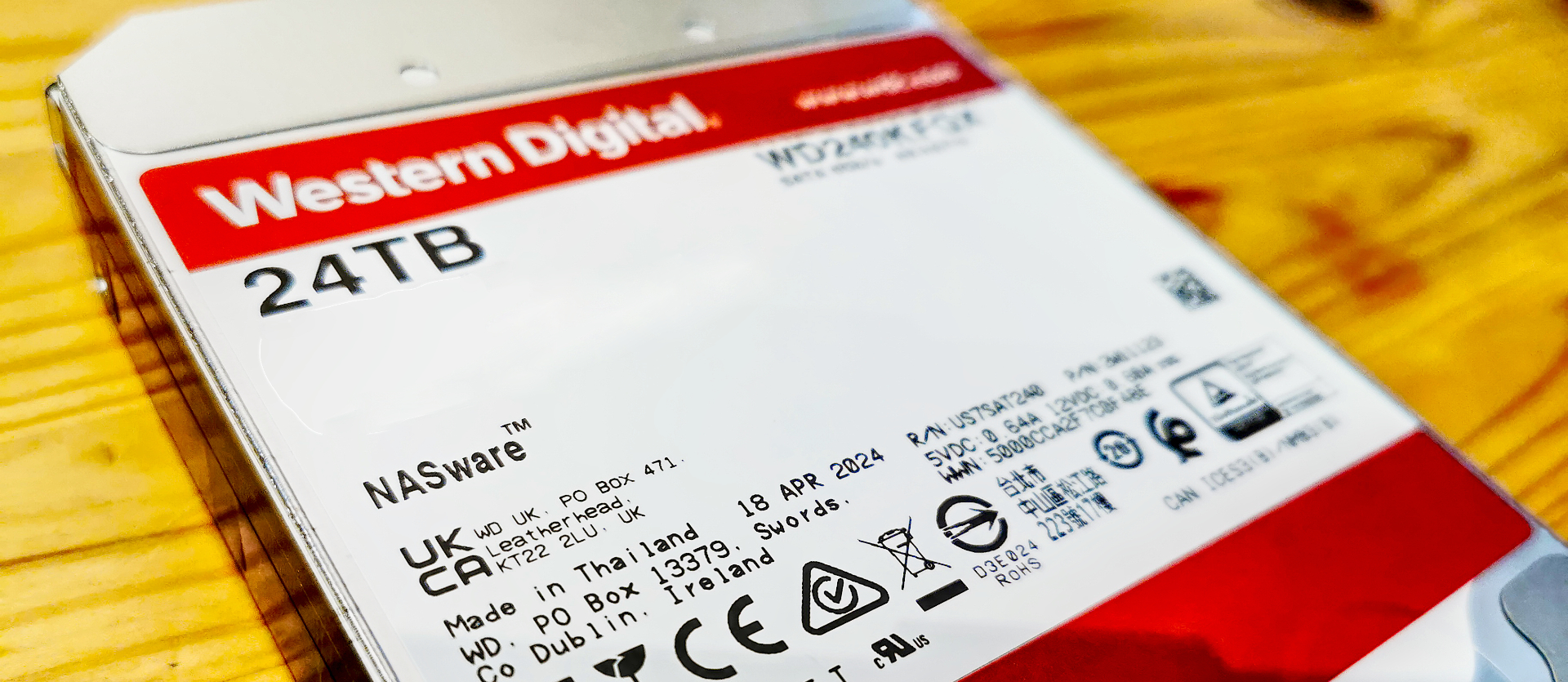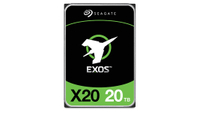TechRadar Verdict
If you need greater capacity and SSD caching to achieve the desired throughput, the 24TB Red Pro is ideal. It's not cheap, and smaller capacities are better value if you use more of them. The best thing about this drive is that it makes the 18, 20, and 22TB models cheaper.
Pros
- +
24TB of capacity
- +
550TB/y workload
- +
OptiNand Technologies
- +
5-year warranty
Cons
- -
Expensive
- -
Not the fastest 24TB drive
- -
Noisy
Why you can trust TechRadar
30-second review
Each year, hard drive makers launch even greater capacities, and this year, Western Digital has added new 24TB drives to its Gold Enterprise and Red Pro ranges.
The WD240KFGX reviewed here is the Red Pro model, and based on the MSRP, it costs $23.75 for each TB on this drive.
This model's rotational speed is 7200rpm, and it uses CMR technology to deliver a maximum transfer speed of around 287MB/s using a SATA 6Gb/s connection.
This drive, like all the other Red Pro models, provides a stable storage array for a NAS box or file server. It enables RAID configurations to combine the speed of multiple drives for much greater throughput than a single mechanism.
How does it differ from the 22TB WD221KFGX model that came before it? Hardly any difference at all other than the extra 2TB.
Technically, this drive is a little faster than the 22TB drive, by around 22MB/s ironically, but there are faster Enterprise drives of this capacity around, including the WD Gold Enterprise 24TB.
From a business perspective, this drive has a few issues. Firstly, leveraging this capacity requires you to buy at least three or more drives so you can make a RAID 5 array from them. When you do that, backing up to 48TB (from three drives with one parity drive) is no minor exercise, and it assumes you have another array big enough to hold all that data. Finally, this capacity can be had from Seagate with its Exos X24 24TB for around $90 less per unit.
Therefore, buying this drive is a serious investment and a commitment to Western Digital, which assumes that the 5-year warranty isn't excessively optimistic on the maker's part.
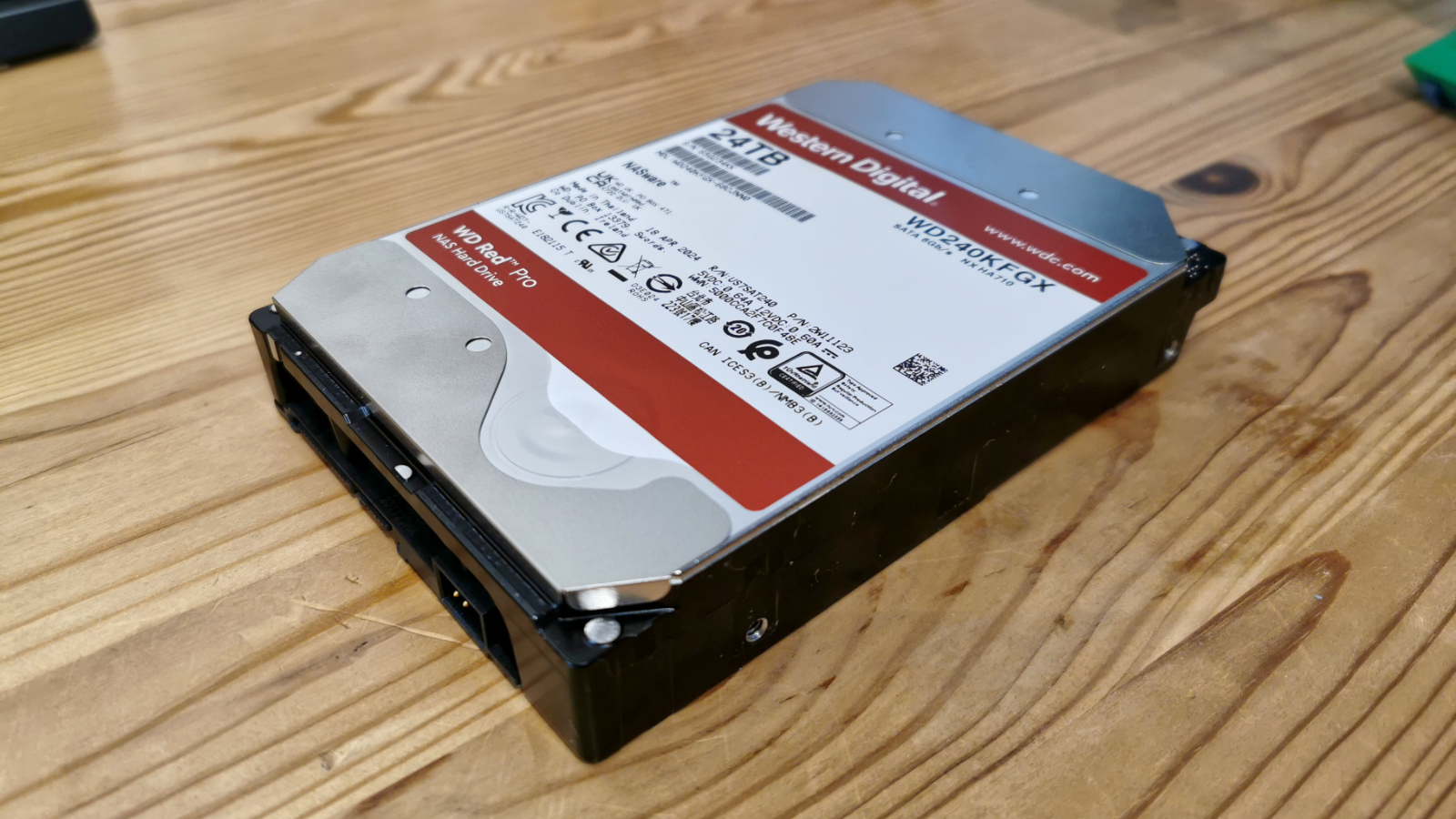
WD Red Pro 24TB: Pricing and availability
- How much does it cost? $570, £615, €760
- When is it out? Available now
- Where can you get it? Sold through online retailers, including Amazon
The RSRP for this drive is $569.99, and the majority of retailers, including Amazon, are sticking to that WD-defined cost for the moment.
For those thinking that sounds expensive, European customers pay significantly more with the same drive, costing £614.09 in the UK and €759.87 in Germany through Amazon.
Given the exchange rate at the time of writing, the UK cost is equivalent to $816.74 in dollars. Or, 43% more.
This appears to suggest that whatever volumes of these drives Western Digital is making, they want to sell most of them in America.
Moving past that pricing differential, how does WD Pro 24TB compare with other models in this series in terms of cost? Not well.
All the drives from 22TB to 14TB cost less per TB, with the 22TB mechanism being the best deal at just over $20 per TB, or $3.74 per TB less. The 22TB Red Pro looks like more of a bargain until you realise that the 26% discount on its official $599.99 price is actually $20 more than when WD released it.
Toshiba and Seagate are the two main WD competitors in this sector. Toshiba has only just announced its 24TB CMR drive, along with a 28TB SMR mechanism, but has nothing on shelves now.
Seagate has the IronWolf Pro 24TB and the Exos X24, which cost exactly the same price, $479.99 for US customers. That's much cheaper than the WD Pro 24TB, and the European pricing is closer to US prices, making the cost proportionally less for those in the UK and Europe. The Seagate IronWolf Pro 24TB is only £476.99 in the UK, or £137.10 less.
However you slice and dice these numbers, the WD Pro 24TB is expensive in the USA, and excessively so in Europe.
- Value: 3.5 / 5
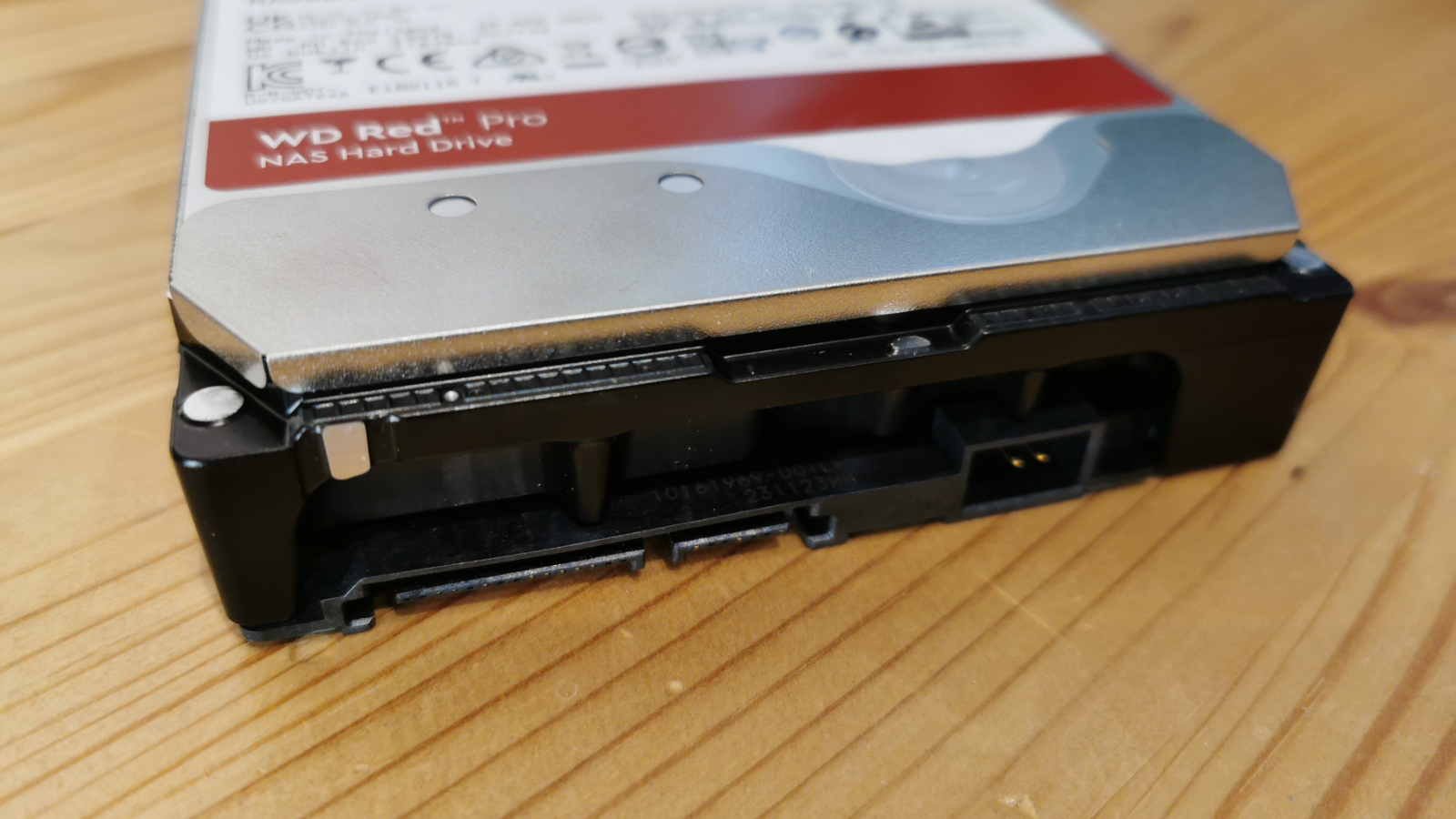
WD Red Pro 24TB: Specs
| Feature | Spec |
|---|---|
| Model No. | WD240KFGX |
| Quoted capacity | 24TB |
| Windows capacity | 24,000,258,367,488 bytes (21.8TB) |
| Recording Technology | CMR |
| Quoted Transfer Speed | 287 MB/s |
| Connection | SATA III 6Gb/s |
| Cache | 512MB |
| RPM | 7200 |
| Encryption | Hardware |
| Weight | 667g |
| Power Active/Idle/Standby | 6.4/3.9/1.2W |
| Yearly Worlkload | 550 TB |
| MTBF | 2.5M hours |
| Warranty | 5-years |
WD Red Pro 24TB: Design
- Identical to 22TB from outside
- 8% more space and speed
- 5-year warranty
To the casual observer, the 24TB WD240KFGX is identical on the outside to the 22TB WD221KFGX that came before it.
Western Digital has become coy about saying how many platters and heads its drives have, presumably because they might change those numbers with higher-density disks.
However, it has 2TB more capacity (9%) and is about 8% faster than the 22TB model.
Given that it has the same cache size and the same rotational speed, an educated guess might be that this drive has an extra platter, maybe eleven, since the 22TB had ten.
Or it has the same number of platters, but each now holds 2.4TB, not 2.2TB, spinning within a factory-sealed helium atmosphere.
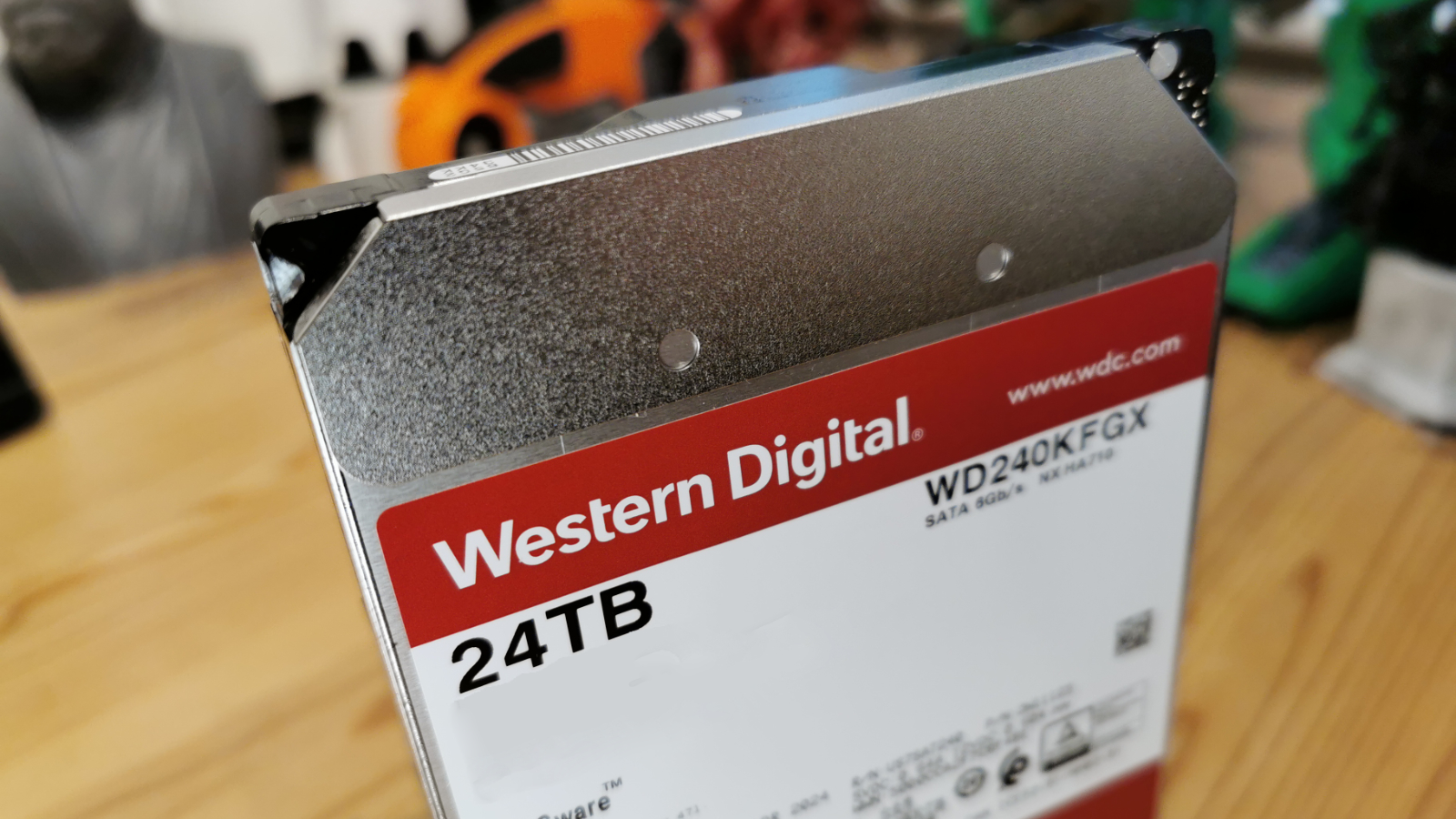
Probably the biggest selling point of this drive, other than the 24TB of capacity, is that this is an OptiNAND drive that uses a NAND flash module to flow all the data through before it's committed to the drive.
This is another attempt at an integrated power loss resilience technology. If the power is cut, whatever was in the NAND won't be lost, and it can be used to write data to the drive once the power returns.
The 100MB of space in the flash module is enough to store metadata relevant to the active write process, manage it efficiently, and avoid the corruption that can decimate a file system when the power gets yanked, in theory.
A technology called ArmorCache was implemented in the WD Gold, and from what we understand, this is also in this drive, even if WD fails to mention this in its documentation.
Those responsible for a file server using drives of this size should run the equipment on an uninterruptable power supply, but having an extra layer of protection is never bad.
This technology was present in the 22TB WD221KFGX, and it is good to see it appear on the latest model.
- Design: 4 / 5
WD Red Pro 24TB: Endurance
- 550TB/Year
- 2.5m hours MTBF
- 5-year warranty
A slight disappointment with this model is that the annual warranty data rate remains unchanged. In fact, the workload of 500TB/year is the same as all WD Red Pro mechanisms, including the 2TB model that is filled with air.
On this drive, with 24TB of capacity, each byte location on the drive would have been rewritten only 23 times to achieve the yearly limit. Or, each byte can only be changed once every 16 days on average, or it will exceed its workload limit.
For those wondering, using an average speed of 250MB/s, it should take 96,000 seconds to read or write the entire contents of the drive, or about 27 hours. Therefore, it's impossible to image this drive on an overnight backup, and if you do have the time to do that, you can only do it 22 times a year, plus the writing of the data is the 23rd operation.
That all the drives get the same workload infers that the workload isn't based on how many times the platters have their data written or read. Instead, it appears to be calculated based on the passage of data through the drive electronics, as the smaller drives will modify the contents many more times than this 24-TB behemoth and get the same workload rate.
All capacities of 14TB or larger also have an MTBF of 2.5m hours, as this drive does.
But to quote Western Digital, "MTBF do not predict an individual drive's reliability and do not constitute a warranty".
Drive makers employ such slippery language in their definitions and EULAs that it's hard to know if the product can achieve its workload in a realistic working environment or if the effort in statistics is based on having a certain percentage of drives die and at what point in their lives.
The nuance of all these factors seems somewhat confusing, and the only element you can rely on is that if you do not exceed your 550TB/year limit—something that seems more likely with drives this big—you have a five-year warranty.
- Endurance: 4 / 5
WD Red Pro 24TB: Performance
- Decent performance
- Noisy in volume
- Excellent power management
| Drive | Header Cell - Column 1 | WD Red Pro 24TB | Seagate EXOS 20TB |
|---|---|---|---|
| Model | Row 0 - Cell 1 | WD240KFGX | ST20000NM007D |
| CrystalDiskMark | Read MB/s | 287 | 289 |
| Row 2 - Cell 0 | Write MB/s | 283 | 285 |
| ATTO | Read MB/s | 283 | 282 |
| Row 4 - Cell 0 | Write MB/s | 277 | 277 |
| AS SSD | Read MB/s | 274 | 275 |
| Row 6 - Cell 0 | Write MB/s | 271 | 270 |
| AJA System Test | Read MB/s | 270 | 275 |
| Row 8 - Cell 0 | Write MB/s | 268 | 273 |
Performance, as predicted by Western Digital, was pretty accurate.
The makers quote a throughput of 287MB/s, not specifying read or write, which is roughly agreed upon by the majority of our synthetic benchmarks.
We’ve presented it against the 20TB Seagate Exos, as we’ve not yet tested the 24TB model of that series.
These benchmarks don’t include some specifics about this drive that are difficult to track accurately. In use, this is a noisy drive, and having a whole rack of these churning away all day in your office wouldn’t be a pleasing experience. WD quotes 32 dBA output, more than the 24 dBA the 24TB IronWolf Pro generates.
That said, it doesn’t generate the cacophony that SMR drives can produce, thankfully.
Along with the noise, the drive also appears to produce a decent amount of heat, so the cooling system must ramp up to keep pace with that.
And when more heat is being generated, more power is typically consumed, or so you might reasonably think.
On paper, this translates to an average power consumption of 6.4W during read/write operations, the same as the EXOS 20TB and less than the 22TB model. However, the idle power draw is 3.9W compared to 3.4W, which the 22TB model demanded to do nothing.
The Seagate 24TB drives (Exos and IronWolf Pro) draw more power on average and as much power on idle as the WD Red Pro while in operation.
Overall, this excellent drive performs similarly to Seagate drives for file transfers but is more frugal with power.
- Performance: 4 / 5
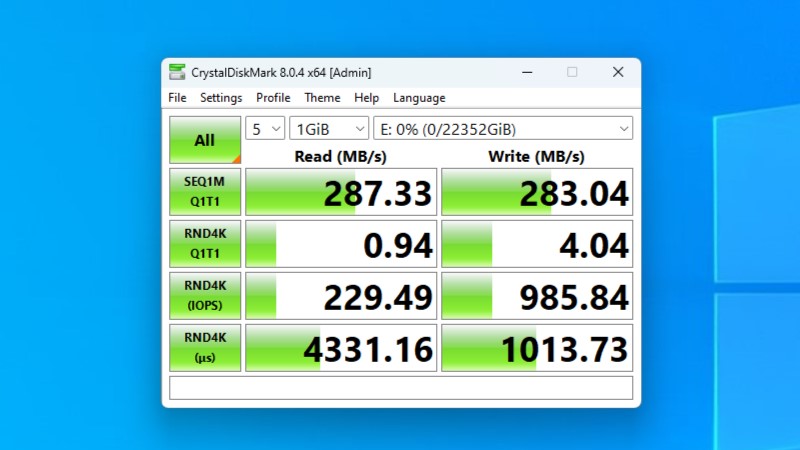
WD Red Pro 24TB: Verdict
There are a few signs that the evolution of these drives is approaching the capacity peak, but we will most likely see 28TB and maybe 32TB before this hardware generation is complete.
What the new 24TB design doesn't address is the management issues that come with capacities this big and that overnight backups that aren't incremental are no longer realistic using conventional drive technology.
Those issues are common to all drives with 24TB, not just the WD Red Pro, but it's something to consider before making a substantial investment in drives of this scale.
Focusing on the WD240KFGX, the pricing is on the high side, especially for European customers. It appears to be designed to tempt customers to spend even more on the WD Gold models, which offer better performance.
The problem for WD with that strategy is that the Seagate drives, IronWolf Pro and Exos, offer similar read and write performance but undercut its prices. The WD Pro 24TB uses less power, which might be a factor if you have a large number of drives. But, better power consumption is unlikely to make a big enough difference to offset the price differential.
If the WD Red Pro 24TB were cheaper, it would be the obvious choice for some applications, but depending on the scale of storage being bought, it might price itself out of some installations.
Should I buy the WD Red Pro 24TB?
| Value | Expensive compared to competitor drives | 3.5 / 5 |
| Design | Effective design that uses Enterprise technologies | 4 / 5 |
| Endurance | Confused endurance message, but a 5-year warranty | 4 / 5 |
| Performance | Performance is good even if these drives are noisy | 4/ 5 |
| Overall | Great drives that are overpriced | 4 / 5 |
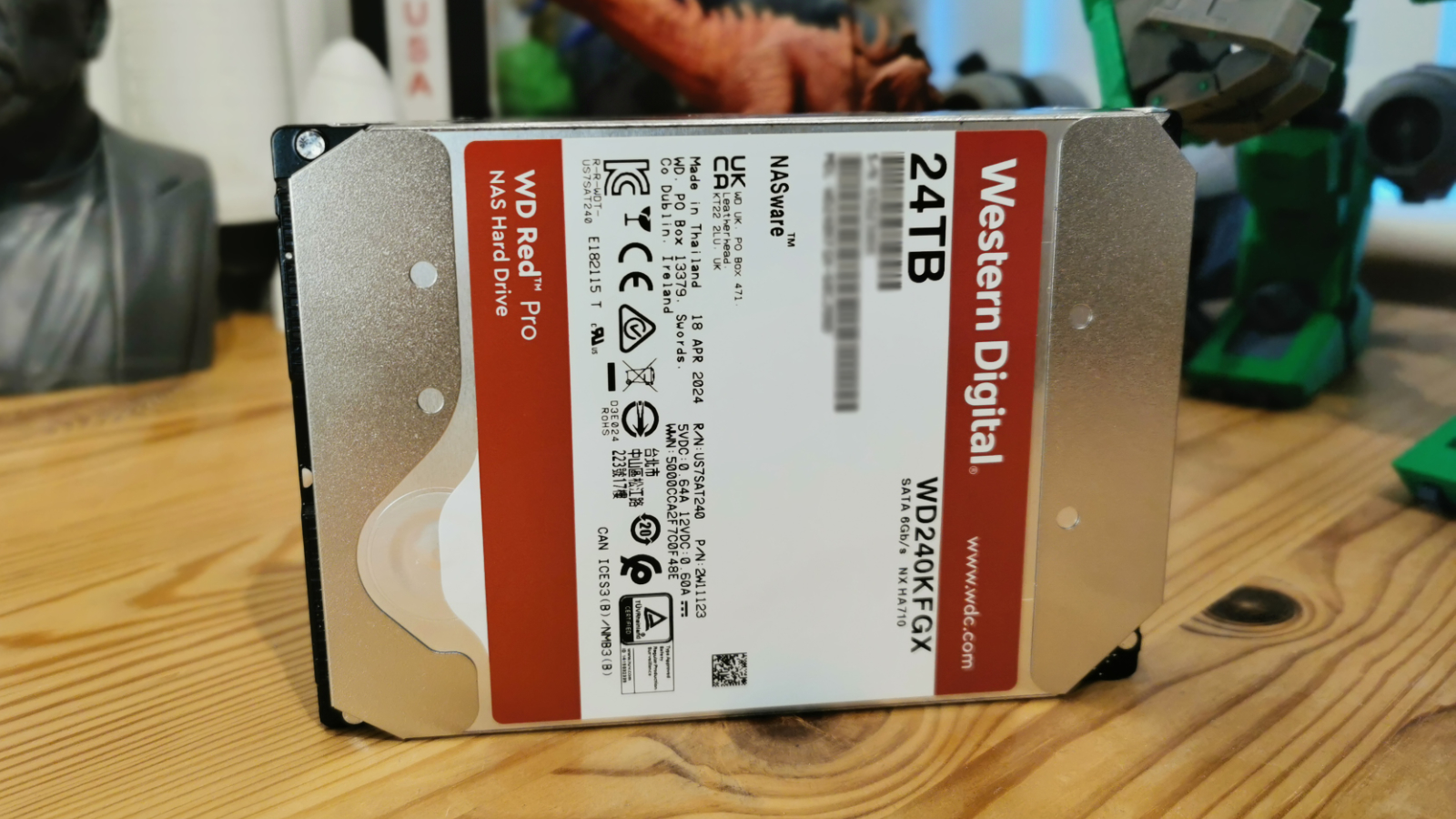
Buy it if...
You have had good WD experiences
All IT managers have brands they trust and others they don't'. These offer good performance and massive capacity for those with a positive experience with Western Digital NAS storage devices. And, if the business can afford them, these are a good choice.
You need more space
If you have a drive array in RAID 5 with six drives using 20TB mechanisms, you will have 100TB of usable space and 20TB allocated to a parity drive to avoid data loss if a drive dies. Replacing those with WD Red Pro 24TB would increase the usable capacity by 20TB to 120TB.
Don't buy it if...
You have a tight budget
The WD Red Pro costs nearly $100 more than its Seagate IronWolf Pro equivalent, so for those buying capacity in volume, those numbers might add up to significant savings by buying elsewhere. Even the Seagate Exos Enterprise drives are cheaper.
If you need a NAS that can be rebuilt in one day
The problem with 24TB drives, of whatever brand, is that it will take you a long time to put all the data back onto the drive if the system needs to be rebuilt. And, if you have a large array, the system might be down for days. Backup management of drives this big is a headache.
Also consider
Seagate X20 EXOS 20TB
A Seagate drive with ten 2TB platters in the classic 3.5-inch form factor to sit alongside the new IronWolf Pro 20TB.
The only significant difference on the outside is that the EXOS comes in SAS flavour and a conventional SATA variety model. It matches the workload limit of 550TB/year on the Red Pro 24TB and is a bit cheaper.
Read our review of the Seagate X20 Exos 20TB
We've covered all the best NAS drives here for you
Mark is an expert on 3D printers, drones and phones. He also covers storage, including SSDs, NAS drives and portable hard drives. He started writing in 1986 and has contributed to MicroMart, PC Format, 3D World, among others.
